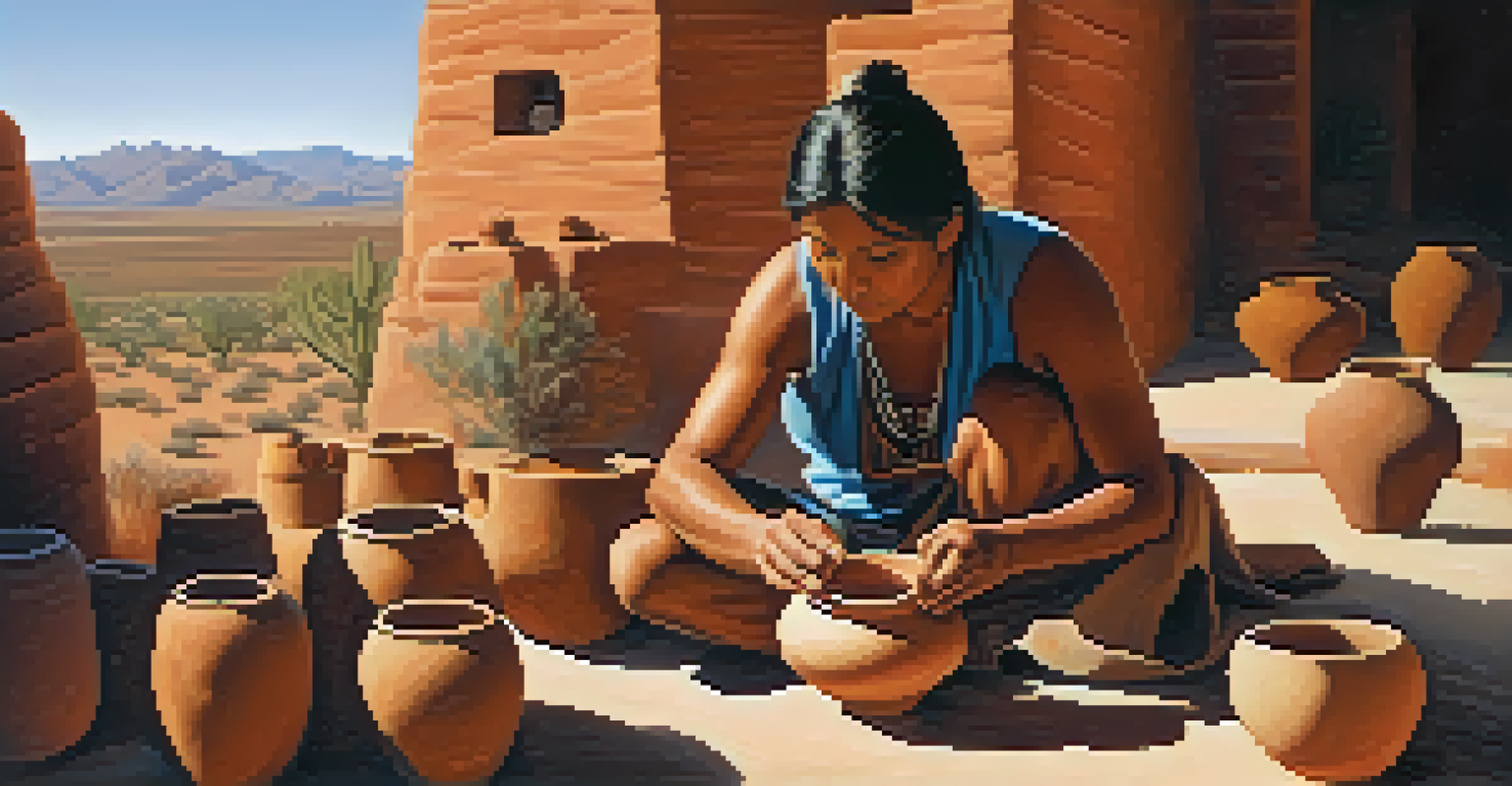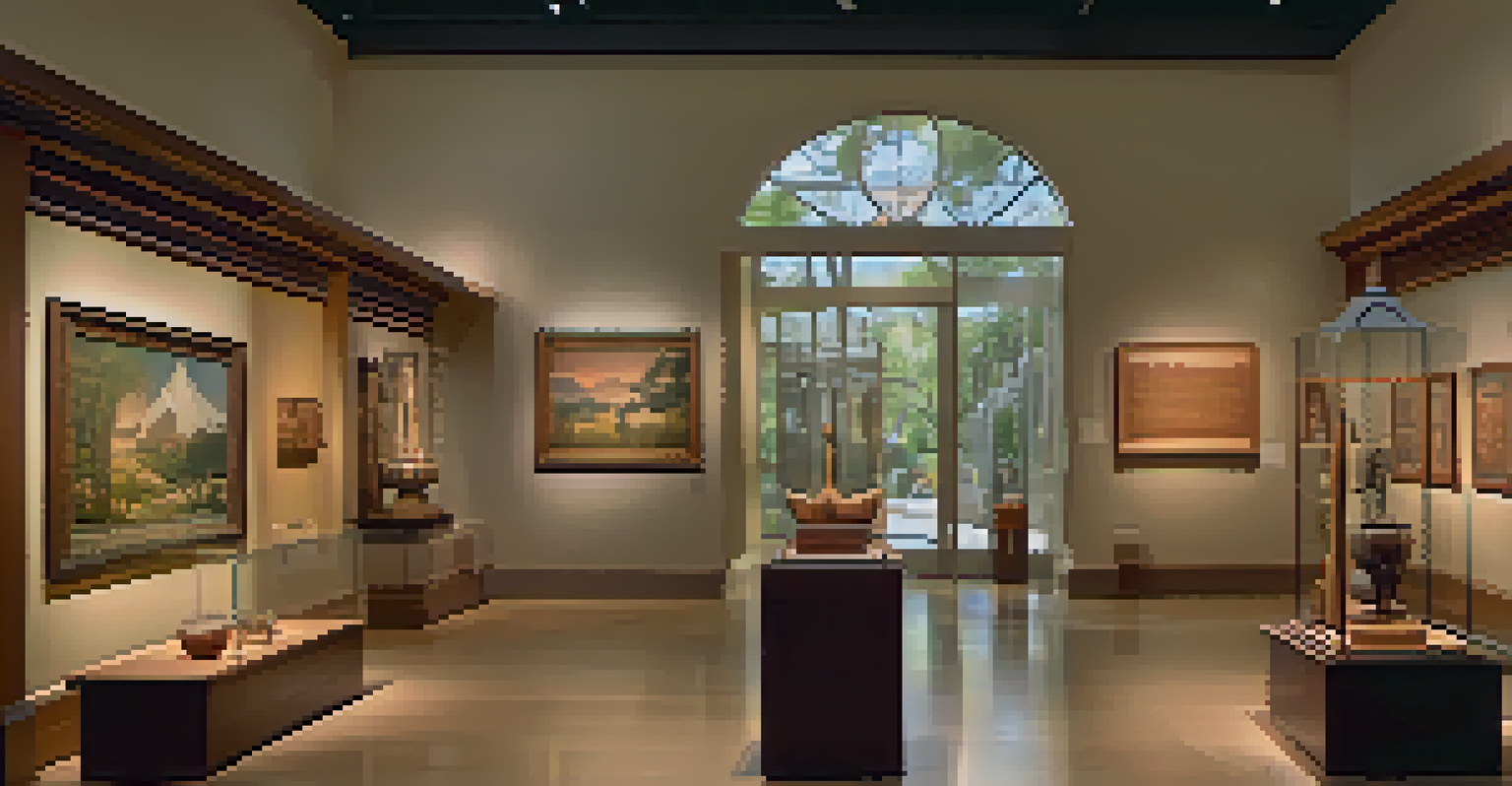Exploring Arizona's Historic Native American Artifacts

The Cultural Significance of Native American Artifacts
Arizona is home to a myriad of Native American tribes, each with its unique history and traditions. These artifacts serve as a window into the lives and cultures of these communities, revealing their daily practices, beliefs, and artistry. From pottery to jewelry, every piece tells a story that connects us to the past and highlights the creativity of Indigenous peoples.
Art is the most beautiful of all lies; it is the only truth we know.
Understanding the cultural significance of these artifacts is essential. They are not just objects; they embody the spiritual and social values of the tribes that created them. For instance, ceremonial items often feature intricate designs that hold deep meanings, reflecting the tribe's relationship with nature and the cosmos.
Moreover, these artifacts are vital for education and preservation efforts. They allow us to appreciate and respect the rich heritage of Arizona's Native American communities, fostering a greater understanding of their contributions to American history.
Major Native American Tribes in Arizona
Arizona is primarily home to several Native American tribes, including the Navajo, Hopi, Apache, and Tohono O'odham. Each tribe has distinct customs and artistry that contribute to the state's cultural mosaic. For example, the Navajo are renowned for their intricate weaving and silverwork, while the Hopi are famous for their pottery and katsina dolls.

The diversity among these tribes is fascinating, as each has its own language, traditions, and art forms. The Apache, known for their beadwork and basketry, use natural materials to create functional and decorative items, while the Tohono O'odham focus on their agricultural heritage, reflected in their crafts.
Cultural Significance of Artifacts
Native American artifacts embody the spiritual and social values of Indigenous tribes, serving as a vital link to their history and traditions.
Exploring the artifacts from these tribes offers a glimpse into their unique worldviews and cultural practices, allowing visitors to appreciate the rich tapestry of Arizona's Indigenous history.
Key Sites to Discover Native American Artifacts
When exploring Arizona, several key sites showcase Native American artifacts. The Heard Museum in Phoenix is a must-visit, featuring an extensive collection of Native American art and cultural exhibits. Here, visitors can engage with the stories behind the artifacts, enhancing their understanding of the tribes' histories.
The past is never dead. It's not even past.
Another significant site is the Navajo Nation, which offers visitors the chance to see traditional crafts and artifacts in their cultural context. From the stunning landscapes to the vibrant markets, the Navajo Nation provides an immersive experience that celebrates their heritage.
Additionally, the Hopi Cultural Center is an excellent place to explore Hopi pottery and crafts. Not only can you see the artifacts, but you can also learn about the artisans and their techniques, making for a truly enriching experience.
Preservation Efforts for Native American Artifacts
Preserving Native American artifacts is crucial for maintaining cultural heritage. Many organizations and museums are dedicated to protecting these items, ensuring they are not lost to time or neglect. This involves careful conservation practices, which help to maintain the integrity of the artifacts.
Collaboration with Native American tribes is essential in these preservation efforts. Tribes often have their own protocols and knowledge regarding their artifacts, making their input invaluable in conservation practices. This partnership helps ensure that the artifacts are preserved in a way that honors their cultural significance.
Preservation and Education Efforts
Collaborative preservation initiatives with Native American tribes are crucial for maintaining the integrity and significance of these cultural artifacts.
Additionally, educational programs are being developed to raise awareness about the importance of these artifacts. By engaging the public, these initiatives aim to foster a sense of responsibility in protecting and respecting Native American heritage.
The Role of Artifacts in Native American Identity
Artifacts play a vital role in shaping Native American identity. They serve as reminders of the past, linking contemporary Indigenous peoples to their ancestors and traditions. This connection fosters a sense of pride and belonging, reinforcing cultural values and practices.
Furthermore, many tribes use artifacts in their cultural ceremonies, where they hold deep spiritual significance. For example, traditional dances may incorporate specific items that symbolize various aspects of life and spirituality, emphasizing the ongoing relevance of these artifacts.
In this way, artifacts not only tell the stories of the past but also contribute to the living culture of Native American tribes today. They are vital for cultural continuity and help keep traditions alive for future generations.
Art and Storytelling in Native American Artifacts
Art and storytelling are intertwined in Native American culture, and artifacts often serve as a canvas for these narratives. Many items are adorned with symbols and designs that carry specific meanings, telling stories of creation, nature, and ancestral heritage. This artistic expression is a vital aspect of cultural identity.
For instance, Navajo rugs feature intricate patterns that convey stories of the weaver's family and their connection to the land. Each design element is intentional, representing elements of their culture and beliefs, making the rug not just a functional item but a powerful narrative tool.
Artifacts and Native Identity
Artifacts play a key role in shaping Native American identity by connecting contemporary Indigenous peoples to their ancestors and cultural practices.
Through these artifacts, Indigenous cultures can communicate their values, history, and experiences. This storytelling aspect enriches the viewer's understanding and appreciation of the artifacts, transforming them from simple objects to profound cultural expressions.
How to Respectfully Engage with Native American Artifacts
Engaging with Native American artifacts requires respect and understanding. It’s essential to recognize their cultural significance and the stories they carry. When visiting museums or cultural sites, take the time to learn about the context of the artifacts and the tribes they represent.
Additionally, when purchasing Native American art or crafts, ensure that it is sourced ethically. Supporting artisans directly and avoiding mass-produced items ensures that your contribution goes back to the communities that create these beautiful works. This practice honors the artists and helps sustain their cultural traditions.

Lastly, be mindful of your behavior and language when discussing Native American artifacts. Approach the subject with sensitivity, acknowledging the ongoing challenges faced by Indigenous communities, and strive to amplify their voices and stories in a respectful manner.